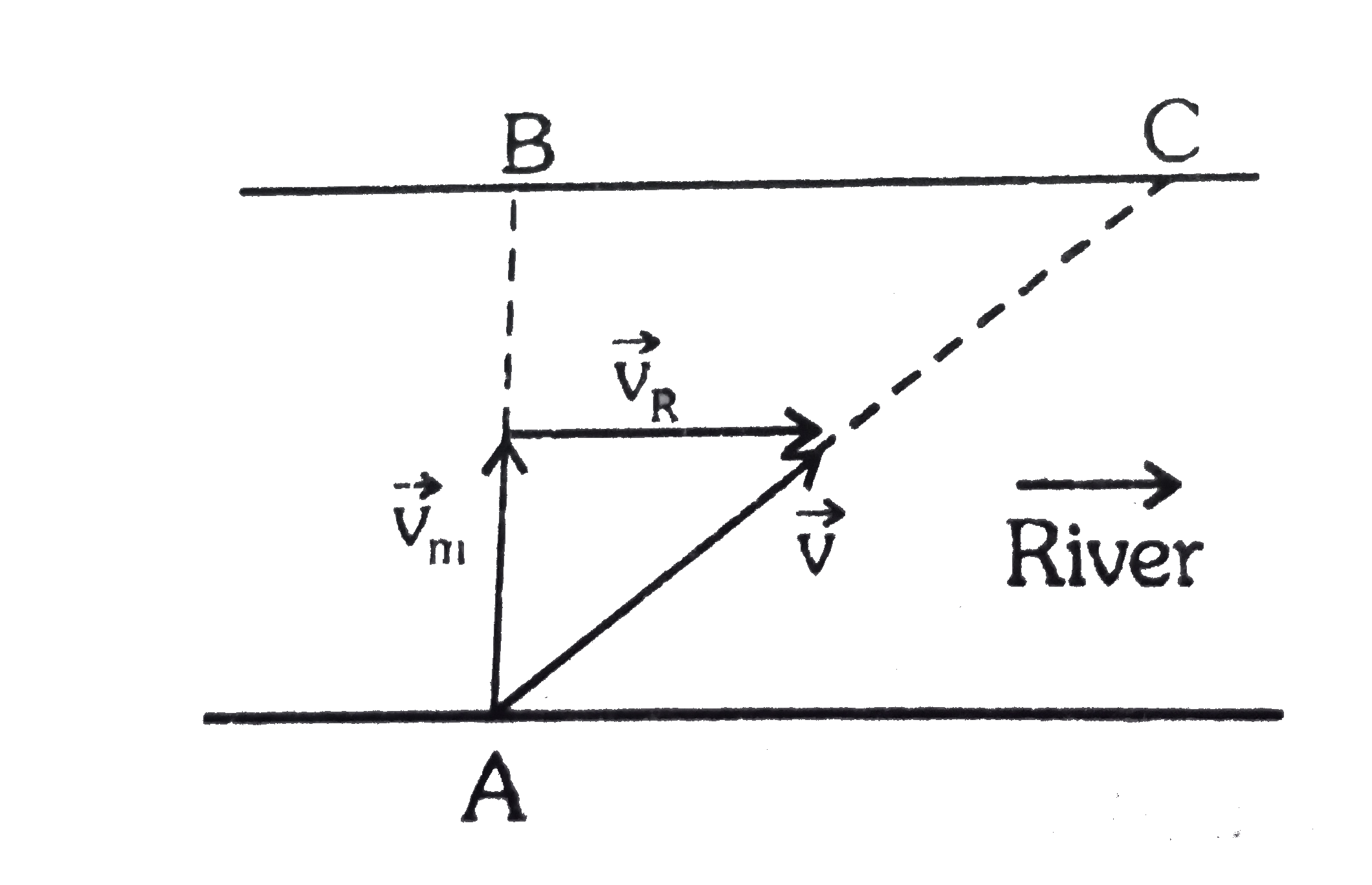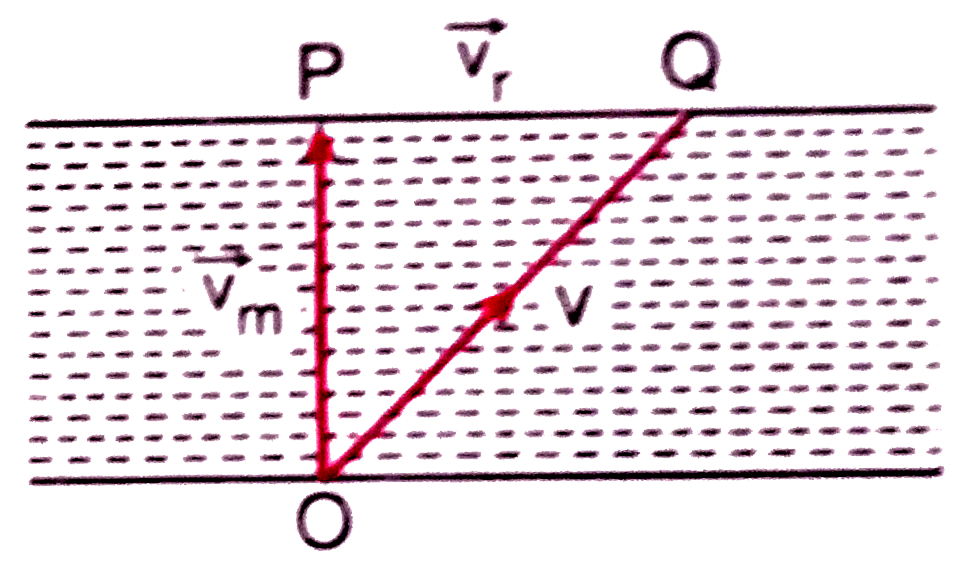A man can swim with a speed of 4.0 km/h in still water . How long does he take to cross a river 1.0 km wide if the river flows steadily at 3.0 km/h and he makes his strokes normal to the river current ? How far down the river does he go when he reaches the other bank ?Solution in Gujrati
(a) time taken t=ABvm=14hr=15 min.
(b) The distance travelled along the river during its crossing is
BC=vR×t=3×14=0.75km

Topper's Solved these Questions
- MOTION IN A PALNEBOOK - ALLEN CHAPTER - MOTION IN A PALNEEXERCISE - EXERCISE-1
99 Videos
- MOTION IN A PALNEBOOK - ALLEN CHAPTER - MOTION IN A PALNEEXERCISE - EXERCISE-2
170 Videos
- MOTION IN A PALNEBOOK - ALLEN CHAPTER - MOTION IN A PALNEEXERCISE - Integer Type Question
3 Videos
- KINEMATICS-2DBOOK - ALLEN CHAPTER - KINEMATICS-2DEXERCISE - Exercise (O-2)
47 Videos
- NEWTON'S LAWS OF MOTION & FRICTIONBOOK - ALLEN CHAPTER - NEWTON'S LAWS OF MOTION & FRICTIONEXERCISE - EXERCISE (JA)
4 Videos
Similar Questions
The distance x of a particle moving in one dimensions, under the action of a constant force is related to time t by the equation, t=√x+3, where x is in metres and t in seconds. Find the displacement of the particle when its velocity is zero.
View SolutionThe velocity of a particle moving with constant acceleration at an instant t0 is 10m/s After 5 seconds of that instant the velocity of the particle is 20m/s. The velocity at 3 second before t0 is:-
View SolutionA stone is dropped from the top of a tower of height h. Aftre 1s another stone is droppped from the balcony 20m below the top. Both reach the bottom simultaneously. What is the value of h ? Take g=10ms−2.
View SolutionA particle is moving in xy-plane .At certain instant the components of its velocity and acceleration are as follows ux=3m/s,uy=4m/s,ax=2m/s2anday=1m/s2. The rate of change of speed at this moment is
View SolutionA piece of wire is bent in the shape of a parabola y=kx2 (y-axis vertical) with a bead of mass m on it. The bead can slide on the wire without friction. It stays at the lowest point of the parabola when the wire is at rest. The wire is now accelerated parallel to the x-axis with a constant acceleration a. The distance of the new equilibrium position of the bead, where the bead can stay at rest with respect to the wire, from the y-axis is:
View SolutionA man can swim with a speed of 4kmh−1 in still water. He crosses a river 1km wise that flows steadly at 3kmh−1. If he makes his strokes normal to the river current, how far down the river does he go when he reaches the other bank?
View SolutionA man can swim at a speed of 5km/h in the still water. He wants to cross a 1600m wide river flowing at 4km/h. He keeps himself at an angle 127∘ with the river flow while swimming. (a) Find the time he takes to cross the river. (b) Find the distance traveled by him along the flow.
View SolutionA man can swim with a speed 4km/hr in still water. (a) How long does he takes to cross a river 1 km wide if the river flows steadily at 3 km/hr and makes his strokes normal to the river current? (b) How far down the river does he go when he go when he reaches the other bank?
View Solutionकोई व्यक्ति स्थिर पानी में 4.0 किमी/घण्टा कि चाल से तेर सकता है उसके 1.0 किमी चौड़े नदी को पार करने में कितना समय लगेगा, यदि नही 3.0 किमी/घण्टा की स्थिर चाल से बह रही हो और वह नदी के बहाव के लंबवत तेर रहा हो | जब वह नदी के दूसरे किनारे पहुँचता है तो वह नदी के बहाव की और कितनी दूर पहनेगा ?

View Solutionकोई व्यक्ति स्थिर पानी में 6.0 किमी/घंटा की चाल से तैर सकता है । उसे 2.0 किमी चौड़ी नदी को पार करने में कितना समय लगेगा यदि नदी 4.0 किमी/घंटा की स्थिर चाल से बह रही हो और वह नदी के बहाव के लंबवत तैर रहा हो । जब वह नदी के दूसरे किनारे पहुँचता है तो वह नदी के बहाव की ओर कितनी दूर पहुँचेगा ?

View Solutionकोई व्यक्ति स्थिर पानी से 4.0 km/h की चाल से तैर सकता है। उसे 1.0 km चौड़ी नहीं को पार करने में कितना समय लगेगा यदि नहीं 3.0 km/h की स्थिर चाल से बह रही हो और वह नदी के बहाव के लंब तैर रहा हो? जब वह नदी के दूसरे किनारे पहुंचता है तो वह नदी के बहाव की ओर कितनी दूर पहूंचेगा?
View Solutionकोई व्यक्ति स्थिर पानी में 0.4 km/h की चाल से तैर सकता है। उसे 1.0 km चौड़ी नदी को पार करने में कितना समय लगेगा यदि नदी 3.0 km/h की स्थिर चाल से बह रही हो और वह नदी के बहाव के लम्बवत् तैर रहा हो। जब वह नदी के दूसरे किनारे पहुँचता है तो वह नदी के बहाव की ओर कितनी दूर पहुँचेगा?
View SolutionA man can swim with a speed of 4.0 km/h in still water . How long does he take to cross a river 1.0 km wide if the river flows steadily at 3.0 km/h and he makes his strokes normal to the river current ? How far down the river does he go when he reaches the other bank ?
View SolutionA man can swim with a speed of 4.0 km/h in still water . How long does he take to cross a river 1.0 km wide if the river flows steadily at 3.0 km/h and he makes his strokes normal to the river current ? How far down the river does he go when he reaches the other bank ?
View SolutionA man can swim with a speed of 4.0 km/h in still water . How long does he take to cross a river 1.0 km wide if the river flows steadily at 3.0 km/h and he makes his strokes normal to the river current ? How far down the river does he go when he reaches the other bank ?
View SolutionA man can swim with a speed of 4.0 km/h in still water . How long does he take to cross a river 1.0 km wide if the river flows steadily at 3.0 km/h and he makes his strokes normal to the river current ? How far down the river does he go when he reaches the other bank ?
View Solution
